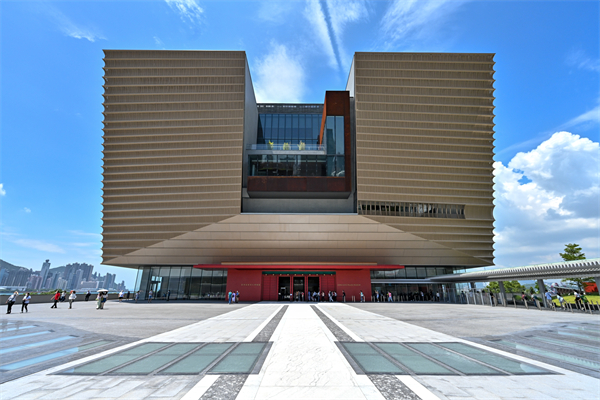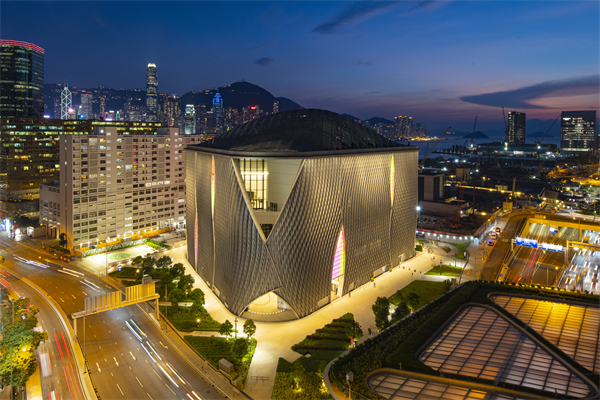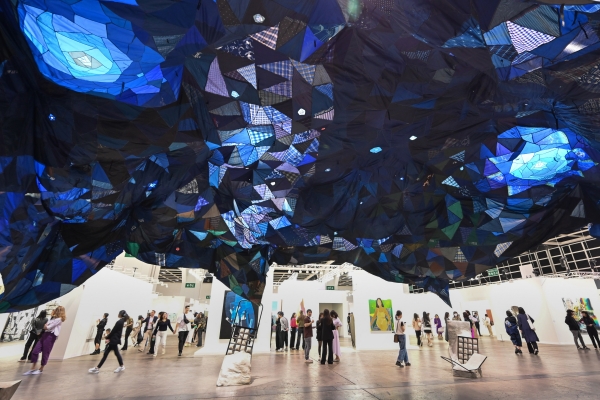HK well-poised to forge dialogue on Chinese culture between global civilizations
Recently, a group of exhibition planners, copy editors and researchers with diverse backgrounds and different native languages were engaged in a debate at Hong Kong Palace Museum (HKPM), a cultural landmark located at the tip of the Kowloon peninsula in Hong Kong. They were trying to determine the best English words to describe an artwork of Chinese calligraphy and painting from ancient times that was on display at the museum.
The HKPM was preparing to publish an English book to help international audiences appreciate Chinese ancient art. The book, which involves contributions from many experts, is set to be available in bookstores and renowned museums overseas.

Hong Kong Palace Museum, a new cultural landmark at the West Kowloon Culture District, inspires international audiences to appreciate Chinese ancient art and culture. [Photo provided by Information Services Department]
The publication is a perfect example of Hong Kong's role in facilitating a dialogue on Chinese culture between global civilizations.
"Hong Kong has a very diverse population," said Louis Ng Chi-wa, director of the HKPM. “In addition to locals, there have been arrivals from the Chinese mainland, Taiwan, and other Asian countries and overseas regions. They have brought different cultures to the city and blended them together well, contributing to the growth of arts and cultural development.”
The HKPM, Ng said, has talents from Hong Kong who are educated in both Chinese and English, making them well-equipped to ensure accurate translation. They are able to present obscure jargon used in the art world in language that is easily understood by the audience.
He added that the HKPM has recruited people from different cultural backgrounds who have extensive networks with mainland and overseas cultural institutions. Many of the researchers have worked overseas, some with decades of international experience.
In Ng's opinion, Hong Kong's multilingual talent can play a crucial role in promoting Chinese culture to Western audiences in an accessible way. This is due to the city's East-meets-West traditions, diverse community, extensive overseas networks and opportunities offered by the Guangdong-Hong Kong-Macao Greater Bay Area blueprint.

The eye-catching Xiqu Centre at the West Kowloon Cultural District provides a tailor-made performance venue for Cantonese opera and other forms of Chinese performing arts, helping to enhance appreciation of Chinese culture and nurture creative talents. [Photo provided by Information Services Department]
Many mainland museums are looking to Hong Kong as a pathway to expand their overseas impact. They are impressed by Hong Kong's influence and international status for planning exhibitions. A recent case in point is the Sanxingdui ruins in Sichuan, the biggest prehistoric city ruins on the upper reaches of the Yangtze River. Ng revealed that the HKPM is currently in discussion with Sichuan authorities to bring artifacts from the ruins for display in Hong Kong. He added that the city could also help to arrange exhibitions of the artifacts overseas.
Ng also noted that through its international networks, Hong Kong can bring many Chinese exhibits to the city and then ship them for display overseas and vice versa. Apart from displaying treasures from the Palace Museum in Beijing, the HKPM will collaborate with international art and cultural institutions to engage in dialogue.
Frankie Yeung Wai-shing, chairman of the advisory panel of the Xiqu Centre in the West Kowloon Cultural District, noted Hong Kong's impressive ability to organize large-scale cultural events and its abundance of newly-built and soon-to-be-completed cultural facilities.
In the past three years, the city has added numerous cultural landmarks, such as the Xiqu Centre, M+ and the HKPM. As stated in the 2022 Policy Address, the government aims to increase the number of public museums under the Leisure and Cultural Services Department to 19 and to increase the seating capacity at performance venues across the city by 50 percent.
According to Yeung, Hong Kong's performing arts have a glorious history, particularly in movies and music. Hong Kong dominated the Asian movie scene in the 1980s, and in recent years new hopes have emerged. For example, the well-crafted low-budget comedy Table for Six, and the city's first home-made hit science fiction movie Warriors of Future performed well at the box office. In terms of music, local groups such as the Hong Kong Chinese Orchestra and the Hong Kong Philharmonic Orchestra have received international acclaim.
Opened in 2019, the Xiqu Centre has achieved impressive results, despite the impact of the pandemic. It frequently invited winners of the Plum Blossom Award, the highest award for Chinese drama performing arts, to perform in the city. In addition, the Xiqu Centre's experimental Cantonese Opera series has created a buzz and received wide recognition. Yeung hopes the Blueprint for Arts and Culture and Creative Industries Development, proposed in the 2022 Policy Address, would further improve the sector’s ecosystem and create more business opportunities.
Vincent Chan, co-president of Hong Kong Art Gallery Association and co-owner of Leo Gallery, pointed out that Hong Kong's sound economic foundation as an international financial center is another reason why world-class art exhibitions, studios and galleries are drawn to the city.
Hong Kong essentially has no consumption tax, well-developed logistics, a free press, a robust insurance regime and a common law system that is familiar to Western buyers. All of these factors are important to the local art market, Chan said.

Visitors enjoy the exhibitions at Art Basel Hong Kong. As one of the most prominent annual international art fairs, this year's edition of Art Basel Hong Kong (Mar 21-25) featured 177 diverse and ambitious exhibitors from 32 countries and regions, reflecting the city's vibrant art and cultural life. [Photo provided by Information Services Department]
In 2020, Hong Kong surpassed London to become the world's second-largest contemporary art auction market, accounting for 23.2 percent of the global art market.
With normalcy resumed in full, an increasing number of international arts and cultural events have resumed and the arts scene is regaining vitality. With the city striving to become an East-meets-West center for international cultural exchange, all of its cultural organizations are gearing up to achieve this goal, especially by fostering collaborations with mainland and overseas counterparts.
Both Ng and Yeung agree that the government has doubled down on its efforts to create a favorable environment for developing arts and culture, and to cement Hong Kong's position as a cultural hub connecting the country with the world.











